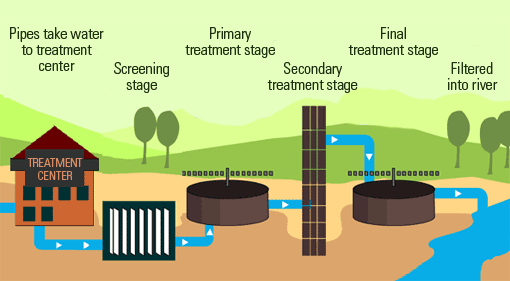The procedure for removing contaminants from the wastewater basically from the household sewage is called sewage treatment. It has to undergo the chemical, physical and biological procedure to remove these contaminants and give out an environmentally safe treated effluent. A semi-solid slurry called the sewage sludge is the by-product of the sewage treatment. This sludge is further processed before it is suitable for land application.
Sewage treatment is also called as wastewater treatment, i.e. it also includes treatment of wastewater from industries. In many cities, the sewer carries a proportion of industrial wastewater to the sewage water treatment plant which has already undergone a treatment in the factories for reducing the pollutant. If it is a combined sewer it will also carry storm water along with it.
The sewage waters travel to the sewage water treatment plants through pipes and pumps. The sewage in the sewage water treatment plant undergoes the following basic processes.
Anaerobic Sewage Treatment
The sewage is partially decomposed by the anaerobic bacteria in the tank without air. This causes the organic matter to reduce to methane, carbon dioxide, hydrogen sulfide etc. this treatment is used to treat organic waste and sludge as it provides huge capacity and greatly reduces the input material to a large extent.

Aerobic Sewage Treatment
In this procedure, the pollutants are digested by the aerobic bacteria. In the sewage water treatment plant air is constantly supplied to the bio-zone. The modern-day aerobic sewage plants make use of natural air currents. This process eliminates the pollutant and odors by providing complete oxidation and absorption of organic pollutant and matter into carbon dioxide, nitrogen, and water. The treated effluent is thus pollutant free and can be discharged for use.
The conventional sewage water treatment plant includes two to three stages namely the primary, secondary and tertiary treatment. Before the process begins rags, sanitary items, clothes etc. are removed from the municipal sewage works.
Primary Treatment
In this process, the effluent or the sewage flows through huge tanks called the primary sedimentation tanks. In these tanks, the sludge settles down while grease and oil float on the surface and are removed. These tanks have scrapers that continuously push the sludge that is collected, towards the hopper in the base of the tank. It is then pumped for the sludge treatment.
Secondary Treatment
In this process, the biological waste from the human waste, soap, food waste, and detergent are substantially degraded. Most of the municipal sewage water treatment plants treat the sewage that is settled through the aerobic process. The effluent after the primary treatment has dissolved biological matter. This is then converted into clean water by making use of the bacterial and waterborne aerobic micro-organisms that absorb the pollutants. The effluents from this process are clean enough to be discharged into the rivers.
Tertiary Treatment
This is the final stage of filtration where the effluent is treated further to its best quality before being discharged to the environment. Sometimes the effluent from the secondary treatment is not clean enough. This is because the river or stream it is going to be discharged it may be very sensitive that might have rare plants and animals. Thus tertiary treatment has to ensure very high standards of treating the effluents to be cleaner than the stream or river water. It reduces the phosphorous and ammoniacal nitrogen.
To remove phosphorous a dosing system is used. On the other hand, removal of ammoniacal nitrogen involves a nitrifying and de-nitrifying process. In this process, the ammoniacal nitrogen is converted to nitrogen gas which is released to the atmosphere and thus leaving the effluent clean.
Sludge Treatment
The sludge that is accumulated in the treatment is further treated and disposed of in a safe manner. The sludge is passed through thickeners that dewater it. This sludge is then transported for disposal in a landfill or used for agriculture soil amendment.
Conclusion
Our earth is surrounded by 70% of water. Out of which only 2.5% is fresh water. 70% of this fresh water is frozen in Antarctica and Greenland. Therefore, only 1% of water is available for our usage. We use water in our daily life for almost everything such as cooking, washing, bathing, toilet, etc. If we recycle water for these purposes, demand for fresh water can be reduced. Therefore, it is important to treat sewage and reuse this treated effluent for washing, floor cleaning etc.
You might also want to check our related posts:

